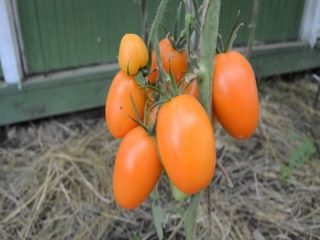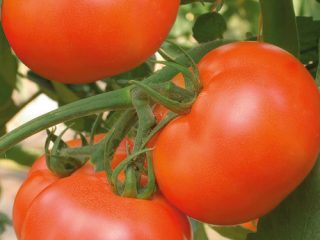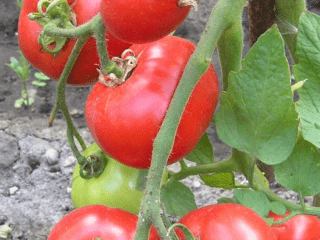Content
If tomatoes on the bushes are rotting, the problem may be fungal diseases or improper agricultural practices. It is necessary to carefully study the symptoms and then treat the culture.
Why rot appeared on tomatoes and what to do
Most often, tomatoes in greenhouses and open ground rot due to fungal diseases. In such cases, you must first determine the type of disease, and then spray the bushes with chemicals or home remedies.
Late blight
Late blight usually appears on tomatoes in the second half of summer, when humidity rises and sharp changes occur between day and night temperatures. Brown spots form on ripening tomatoes, the fruits become deformed and rot, and eventually become completely black. Affected tomatoes fall off the bushes, and the volume of edible harvest is sharply reduced.
It is quite difficult to combat late blight in the later stages. But if dark spots have just appeared on the fruit, it makes sense to spray with preparations containing copper.Fitosporin and Trichoderma, as well as Gamair and Alirin have a good effect. Treatments are carried out in accordance with the instructions 2-3 times at ten-day intervals.

To prevent late blight, it is useful to treat tomatoes with a solution of boric acid 5 ml per 10 liters of water
Alternaria blight
Alternaria blight is a disease whose causative agent loves high humidity and warm weather. Most often, the disease appears on tomatoes after heavy rains or during sudden temperature changes that provoke dew. The disease can be recognized by gray-brown spots on leaves and shoots, as well as small brown marks on ripening fruits. Gradually, the spots grow and darken, the tomatoes rot, become deformed and become unsuitable for food.
The causative agent of the disease usually enters tomatoes through contaminated garden tools, along with wind or water. Sometimes tomatoes become infected from potatoes growing nearby, which also often suffer from Alternaria blight.

Alternaria of tomatoes develops at a temperature of 23-30 ° C
If symptoms of the disease appear, it is necessary to urgently spray the bushes with Oxyx or Bordeaux mixture. Treatments are repeated weekly until signs of the disease disappear. In this case, all affected fruits must be picked and thrown away before treatment begins, otherwise the fungus will continue to spread throughout the plantings.
Anthracnose
A dangerous fungal disease of tomatoes manifests itself as small light spots on the fruit. At the first stages, the markings are almost the same color as the skin.First, the disease affects tomatoes located close to the soil, then it spreads to the root system and stem. Gradually, the spots on the fruit increase in size and acquire a dark border. With advanced anthracnose, tomatoes rot and crack, soften and finally die. Even with mild damage, the fruits become watery and tasteless.

Anthracnose usually affects tomatoes at a temperature of 22-24 ° C
Anthracnose appears on tomatoes most often in mid-summer. Sometimes the symptoms of the disease become noticeable only after harvesting. It is impossible to cure already damaged fruits; all that remains is to throw them away.
If symptoms of anthracnose appear at the ripening stage, you should immediately remove tomatoes with spots on the skin. The bushes are then treated with 1% Bordeaux mixture or copper oxychloride. Controlling the intensity of moisture and regular thinning of plantings help prevent anthracnose.
Gray rot
Tomatoes rot when ripe due to white rot. The disease does not immediately affect the fruits - first the leaves become covered with small spots. Then the marks increase in size, and a fluffy grayish coating forms on the plates. Gradually it spreads to the stems and ripening tomatoes, which also rot. The fungus quickly spreads through the bushes, so gray rot causes serious damage to the crop.

Gray rot, which spoils tomatoes, appears due to waterlogging and excess nitrogen in the soil
The disease is controlled using fungicides.In particular, you can use a solution of copper sulfate - add 5 g of the product and a glass of wood ash to 10 liters of water. It is also allowed to use Fitosporin and Bordeaux mixture.
To avoid the appearance of gray rot on tomatoes, you need to monitor the degree of soil moisture and avoid waterlogging. Before planting bushes, the soil should be disinfected with Trichodermin or a solution of potassium permanganate.
White rot on tomatoes
White rot on tomatoes in the first stages affects the lower leaves of the bushes and fruits located near the ground. First, the plates become watery, lose color and elasticity. Then a characteristic white coating appears on them, which spreads to the tomatoes, and the fruits rot.
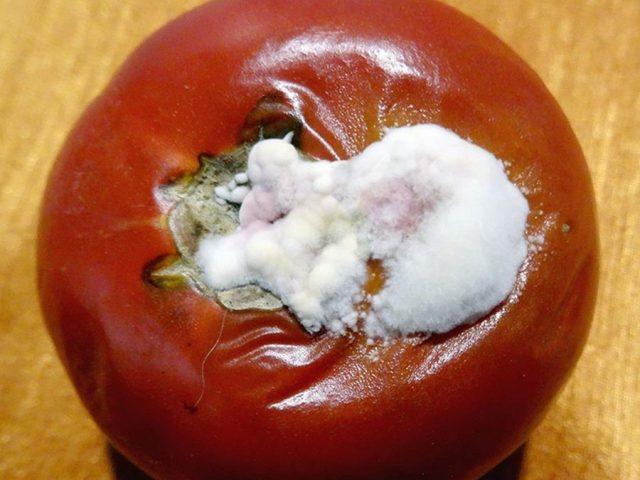
White rot on tomatoes develops with high humidity in cool weather.
When symptoms of the disease appear, it is necessary to remove the affected tomatoes and trim off the leaves affected by the fungus. After this, the bushes are sprayed with copper sulfate or Bordeaux mixture. To improve the health of tomatoes, it is also recommended to feed the crop with urea and add zinc to the soil.
Black rot on tomatoes
Black rot of tomatoes usually appears due to violation of growing rules. Small dark green spots first form on the leaves of the crop, which gradually increase in size. Then black marks appear on the tops of the fruits. Tomatoes rot, lose their attractive appearance, and become unsuitable for salads and canning.

Black rot is not caused by a fungus, but by ordinary waterlogged soil.
If tomatoes rot and turn black, you need to urgently remove all affected parts and treat the bushes with copper preparations. It is also important to adjust the intensity of watering. If the soil remains too wet, the treatment will not work and the new fruit will still rot.
Apical rot
If tomatoes begin to rot at the tips of the fruit, we are talking about blossom end rot - a dangerous and common disease. It appears against the background of violations of agricultural technology, and sometimes develops against the background of a primary fungal disease. Most often, the disease occurs when the soil is swampy, due to cracking of fruits, with an excess of nitrogen and a lack of calcium in the soil.
In the first stages of development of the disease, a brown spot forms at the very top of the tomato, which gradually increases in diameter. The fruit at the site of the lesion softens and rots. Over time, the disease spreads over the entire surface of the tomato and makes it unfit for consumption.

In case of blossom end rot, diseased fruits should be destroyed, and healthy ones should be picked green and left to ripen indoors.
Blight rot can be cured at an early stage by spraying with calcium chloride 0.2%. Treatments are repeated twice a week until symptoms disappear. Controlling the intensity of moisture and feeding tomatoes with calcium and potassium help prevent the development of the disease. As a preventive measure, it is allowed to use folk remedies for tomato rot. For example, you can regularly spray with a solution of iodine or boric acid.
Wet rot of tomatoes
Wet rot of tomatoes usually occurs at the last stage of fruit ripening.Ripe tomatoes become covered with watery spots, begin to crack, and white mold appears in areas of damage. The fruits soften and emit an unpleasant aroma, the stems of the bushes turn brown and also lose their elasticity.

Wet rot occurs most often in tomatoes in open ground and in overripe fruits in storage.
Wet rot develops at a temperature of about 30 ° C and at high humidity. The disease is often transmitted by parasites - caterpillars, onion flies, and whiteflies. Tomatoes can be treated for rot with 1% Bordeaux mixture. It is quite difficult to combat the disease, so the main attention is paid to prevention - remove tomatoes from the bushes in a timely manner, control the volume of nitrogen fertilizing and regularly fertilize the crop with potassium.
Black spot
Black spot is a bacterial disease that affects tomatoes at any stage of the growing season. With this disease, small olive-colored spots up to 2 mm in diameter form on the leaves. If the culture is not treated, the marks darken and grow.

Omats often suffer from black spotting when near sweet peppers
The fight against the disease is carried out using Bordeaux mixture and iodine solution. It is also necessary to clear the beds of plant residues and adjust the intensity of watering.
Bacteriosis
Treatment of tomatoes against rot must be carried out in case of bacteriosis. A dangerous disease can develop on bushes in just a day. When affected by this disease, the stems of tomatoes rot from the inside, soften, crack and lie down.
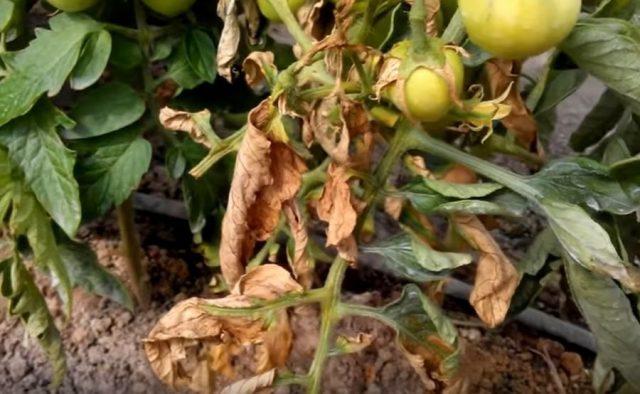
Tomato bacteriosis is also called bacterial wilt or canker.
Bacteria that provoke the development of the disease enter the culture tissue through mechanical damage along with water during irrigation.The disease is especially dangerous in hot weather with a humidity level of more than 60%. Sometimes the pathogen enters tomatoes from infected soil. Bacteriosis can also develop when contaminated seeds are used.
The disease cannot be treated, so the affected bushes are immediately destroyed, and healthy ones are treated with the tomato rot drug Fitolavin-300 1% or Bordeaux mixture. If tomatoes have begun to spoil, you should not eat them - this can be dangerous for the body. In addition, the taste of the fruit changes for the worse.
Improper care
If there are no symptoms of fungal diseases, and it is not clear why the tomatoes are rotting, it is necessary to evaluate the quality of crop care. Ripening fruits may suffer for several reasons:
- due to a lack of calcium, the walls of the tomatoes in this case begin to let in any infections;
- due to increased or insufficient humidity, the tomatoes’ metabolic processes are disrupted and they rot;
- due to boron deficiency - in this case, tomato bushes absorb calcium worse.
Tomatoes often rot when the root system is damaged. Infections easily enter tissues, and the culture's resistance to diseases decreases.
Why do tomatoes rot in a greenhouse?
You have to fight rot on tomatoes both in open ground and in greenhouse conditions. In a greenhouse, ripening fruits usually suffer due to basic violations of agricultural technology. In particular, tomatoes rot:
- against the background of too high humidity in the greenhouse;
- with sudden changes between day and night temperatures;
- with dense planting of bushes and rare ventilation of the greenhouse;
- if there is an excess of nitrogen in the soil - in this situation, tomatoes absorb other useful substances worse;
- If crop rotation is not observed, it is undesirable to plant tomato bushes in one place for several seasons in a row.
The fight against rot of tomatoes in a greenhouse is carried out using the same methods as in open ground. But special attention should be paid to adjusting growing conditions. If care is not improved, ripening fruits will continue to rot, and therapeutic sprays will not give any result.

Tomatoes in a greenhouse rot due to damage from thrips and aphids
Preventive measures
Getting rid of rot on tomatoes can be quite difficult. The main attention should be paid to disease prevention:
- thoroughly disinfect the soil before planting tomatoes;
- treat seeds, especially if they are collected with your own hands;
- do not plant tomatoes next to infected crops;
- avoid waterlogging the soil when caring for bushes;
- regularly apply complex fertilizers with a predominant content of potassium and calcium;
- avoid thickening of plantings and promptly plant and form bushes.
When choosing tomatoes for planting, you should give preference to varieties with high immunity to diseases. When growing bushes, you need to monitor the condition of the greenhouse or open ground and promptly remove plant debris from the surface of the ground.
Resistant varieties
Some varieties of tomatoes rot due to fungal diseases and improper care less often than others. In particular, the following have high immunity:
- Pharaoh. The hybrid variety ripens within 115 days after planting and almost does not rot from temperature changes and waterlogging. Brings up to 12 kg of ripe fruits from 1 m2.
Pharaoh tomato fruits reach 200 g in weight
- Bolshevik. An early-ripening tomato variety produces round, slightly flattened tomatoes with bright red skin. It has a rich aroma and pleasant taste. Rarely suffers from fungi; with good care, it does not rot from unfavorable weather.
The Bolshevik tomato ripens in an average of 110 days
- Benito. A high-yielding tomato hybrid produces plum-shaped, bright red fruits. Ripens within 100 days. Tomatoes reach only 70 g in weight and have excellent taste.
When growing a Benito tomato from 1 m2 of beds, you can harvest up to 25 kg of crop
Even disease-resistant tomatoes will sometimes rot if not well cared for. When growing any variety, it is necessary to follow agricultural techniques.
Conclusion
When tomatoes rot in a greenhouse or in open beds, the cause is most often fungal diseases. Sometimes the problem is also caused by waterlogging of the soil or its inappropriate composition.







